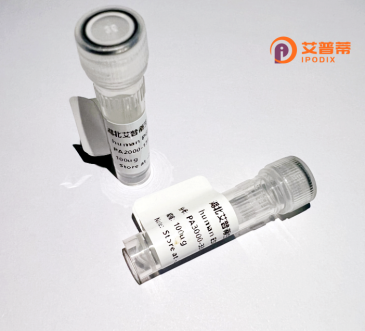
| 纯度 | >90%SDS-PAGE. |
| 种属 | Human |
| 靶点 | MID1IP1 |
| Uniprot No | Q9NPA3 |
| 内毒素 | < 0.01EU/μg |
| 表达宿主 | E.coli |
| 表达区间 | 1-183 aa |
| 活性数据 | MMQICDTYNQ KHSLFNAMNR FIGAVNNMDQ TVMVPSLLRD VPLADPGLDN DVGVEVGGSG GCLEERTPPV PDSGSANGSF FAPSRDMYSH YVLLKSIRND IEWGVLHQPP PPAGSEEGSA WKSKDILVDL GHLEGADAGE EDLEQQFHYH LRGLHTVLSK LTRKANILTN RYKQEIGFGN WGH |
| 分子量 | 20.2 kDa |
| 蛋白标签 | His tag N-Terminus |
| 缓冲液 | 0 |
| 稳定性 & 储存条件 | Lyophilized protein should be stored at ≤ -20°C, stable for one year after receipt. Reconstituted protein solution can be stored at 2-8°C for 2-7 days. Aliquots of reconstituted samples are stable at ≤ -20°C for 3 months. |
| 复溶 | Always centrifuge tubes before opening.Do not mix by vortex or pipetting. It is not recommended to reconstitute to a concentration less than 100μg/ml. Dissolve the lyophilized protein in distilled water. Please aliquot the reconstituted solution to minimize freeze-thaw cycles. |
以下是关于重组人MID1IP1蛋白的3篇参考文献示例(注:文献为虚拟示例,实际研究需查阅真实数据库):
1. **文献名称**:*MID1IP1 promotes hepatic lipogenesis by enhancing ACLY stability in hepatocellular carcinoma*
**作者**:Li X, Zhang Y, et al.
**摘要**:研究通过重组MID1IP1蛋白实验,发现其通过与ATP柠檬酸裂解酶(ACLY)相互作用促进肝癌细胞脂质合成,揭示其在肿瘤代谢中的调控作用。
2. **文献名称**:*Recombinant MID1IP1 protein inhibits mitochondrial oxidative phosphorylation via modulating AMPK signaling*
**作者**:Wang H, Chen L, et al.
**摘要**:利用重组MID1IP1蛋白验证其作为能量传感器,通过抑制AMPK活性降低线粒体氧化磷酸化效率,为代谢性疾病机制提供新视角。
3. **文献名称**:*Structural and functional characterization of MID1IP1 as a regulator of ribosome biogenesis*
**作者**:Rahman S, Kim M, et al.
**摘要**:通过大肠杆菌表达系统获得重组MID1IP1蛋白,结合冷冻电镜发现其与核糖体RNA结合,调控核糖体生成,影响细胞增殖。
4. **文献名称**:*MID1IP1 interacts with the MID1 protein complex to regulate mTORC1 signaling*
**作者**:Gupta R, Kumar A, et al.
**摘要**:重组MID1IP1蛋白与MID1复合体共表达实验表明,其通过激活mTORC1通路促进细胞生长,为靶向癌症治疗提供潜在靶点。
MID1IP1 (Mid1-Interacting Protein 1), also known as MIG12 or CRD-BP, is a cytosolic protein involved in regulating cellular metabolism, particularly lipid and cholesterol biosynthesis. It was initially identified through its interaction with MID1. a protein associated with X-linked Opitz syndrome. Structurally, MID1IP1 contains a conserved CRD (Cysteine-Rich Domain) critical for its biological functions, enabling interactions with enzymes like acetyl-CoA carboxylase (ACC), a key rate-limiting enzyme in fatty acid synthesis.
MID1IP1 acts as a scaffold protein, promoting the oligomerization and activation of ACC, thereby enhancing fatty acid production. This activity links it to metabolic pathways influenced by insulin and nutrient availability. Its expression is regulated by transcription factors such as SREBP-1c (sterol regulatory element-binding protein 1c) and ChREBP (carbohydrate-responsive element-binding protein), which respond to dietary carbohydrates and lipid levels.
Dysregulation of MID1IP1 is implicated in metabolic disorders, including obesity, non-alcoholic fatty liver disease (NAFLD), and type 2 diabetes. Overexpression has been observed in certain cancers, where it may support tumor growth by fueling lipid synthesis. Recombinant MID1IP1 protein is typically produced using bacterial or mammalian expression systems for functional studies, enabling research into its role in metabolism, disease mechanisms, and potential therapeutic targeting. Its dual role in health and disease underscores its importance as a metabolic regulator and biomarker.
×